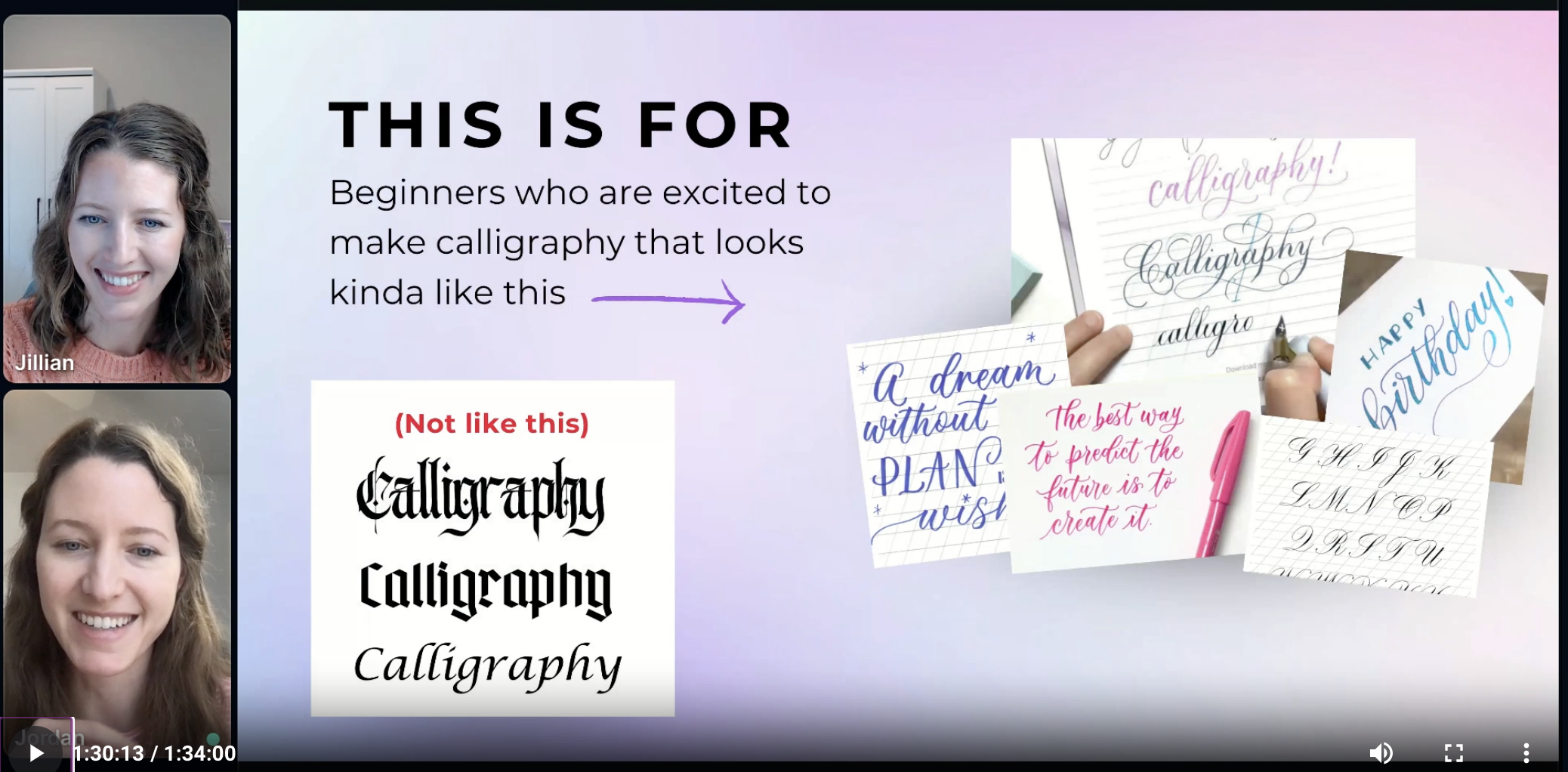Starting A Calligraphy Business: 8 Steps (+ Our Story)
One day you're writing your first words in calligraphy, and the next you're running a successful calligraphy business that's replaced your normal job. *record scratch*
No, that's not normally how the process goes! The dream of being a professional calligrapher exists (we're both living proof, as are many other calligraphers), but it's not an instant or easy business.
Figuring out how to start a calligraphy business is a slightly complex topic, but not in the way you think: If you're already a caligrapher, you could very well make money with calligraphy within the next month (we'll show you how). The complexity relies on deciding which path to take to build a sustainable small business.
Pin it for later! ↓
Table of Contents
In this blog post, we're going to answer all of the FAQs about starting a calligraphy business. We'll show you:
How to build (and maintain) a solid foundation for your skills.
Practical advice for aspiring entrepreneurs.
Our business story and lessons learned.
It isn’t uncommon for talented creatives to want to start earning money with calligraphy. We’ve done the same—first by selling our work to the odd family member or friend, then at local craft shows, and eventually teaching others how to create their own calligraphy.
We're Jordan (left) and Jillian (right), the founders of Loveleigh Loops. We've been teaching workshops in-person and online since 2017 and have taught 45,000+ online students in more than 150 countries.
You don't need expert business skills or an extremely detailed business plan to start a calligraphy business. Read on for dozens of product ideas plus advice from our long journeys in the calligraphy biz. Learn even more in our calligraphy business course:
Are You Ready For A Calligraphy Business?
This is a question we get a lot... Am I ready to launch my calligraphy business or should I practice more? Here are 4 clues that suggest you're ready to start your own calligraphy business:
You would be proud to own what you're selling
You're meeting a need in the market
You feel confident and excited to try
Friends and family have said “You should sell that!” or “Can I buy that?”
Comments like these helped us realize the potential of a calligraphy business. Maybe the best question to ask yourself is this: Am I proud of my work? Once you're confident showing your work to others, we believe you're ready to try selling.
Some calligraphy that we created for our weddings
Is Calligraphy A Profitable Business?
Yes, calligraphy is a profitable small business idea - or at least, calligraphy CAN be very profitable. A lettering business is just like starting any other business: you have to develop a product, find an audience and price your work at A) a level that people can afford and B) you profit from. Most businesses require a lot of work before you make a sale and build something sustainable, but the payoff is huge for those who are successful.
How Fast Can You Make Money With Calligraphy?
You can make money with calligraphy within your first month* of trying to monetize. If you already have a product that you've made (like greeting cards, handwritten notebooks, etc.), you can get a sale in your first month by letting your personal network know that you're selling your work:
Your family and friends
Facebook network
Colleagues
*Note that this doesn't account for the months or years spent learning your craft.
Our first 2 months of selling calligraphy work came from family, friends and co-workers. It was right after 2 months that we got our first customer through Etsy that wasn’t someone we knew.
We made our first dollar by selling products, but didn't find our main business model (teaching) until after some experimentation
How Long Does It Take To Make A Living With Calligraphy?
The amount of time it takes to make a living with calligraphy depends on what kind of product or service you offer and how big your network is. To try to get a realistic image of what this would look like for you, try answering these questions:
How much money do you need to make per week to cover your living expenses?
How much money does your product or services sell for?
What's the profit on each sale?
With these numbers, you can see how many products you'd need to sell per week to cover per week to cover your living expenses.
Example calculation: Let's say you make handmade greeting cards that have a profit margin of $5. If you want to make $500 weekly, you'd need time to make and sell 100 greeting cards per week.
Hitting these quotas is faster when you have a network built up, such as a social following or (even better) a list of email subscribers so that you can get in contact with your network.
Is Monetizing Right For Every Calligrapher?
Just because you’re good at something doesn’t mean that you should automatically turn it into a business. Selling pieces of your art is a completely different (beautiful) beast than creating art for fun. While anyone can learn calligraphy, making money from an online calligraphy business is not for everyone.
But if you decide to become a full-time calligrapher, here’s what we recommend.
Ways To Make Money With Calligraphy
There are two primary umbrella terms that we use to discuss calligraphy businesses: service-based or product-based. Services (such as wedding calligraphy) are custom-made for clients, and products (such as greeting cards) are sold to any customers. Here are the different pros and cons.
Selling Physical Products
Selling physical products is one of the easiest ways to start monetizing your calligraphy.
Calligraphy notebooks from our early days in business
You have so many options! These ideas are just the tip of the iceberg:
Reproduced prints, quotes, signs etc.
Merchandise: hats, t-shirts, etc.
Handmade greeting cards
Christmas cards
Home decor
Event decor
Physical product pros:
Complete control. Making products to sell at craft fairs or on your own website is something you can do from home and on your own time.
Diverse income. With online shops as well as hobby stores and fairs, you have plenty of places to sell your crafts.
Easy startup. If you have the supplies on hand, you can create products to sell almost immediately.
Greeting cards are a popular product. Here's one that we used to sell in our Etsy shop
Physical product cons:
Inventory management. Keeping track of who bought what and getting everything out the door to the right address is a juggling act.
Risk of endless inventory. You can end up with crates of products that nobody ever buys.
This is a great option for anyone looking for a side hustle or to start a business and see where it takes them. For us, it was a good starting point but not something scalable because it kept us in a time-for-money exchange. However, not all products are like this, which brings us to digital products.
Selling Digital Products
If the idea of keeping a physical inventory is stressing you out, consider digital products instead. In today's digital age, there's no longer a need to keep a physical inventory of products you might one day sell.
Rather than keeping a collection of cards or mugs around, think of products like:
One of the biggest hurdles with selling digital products is the learning curve. On top of needing the calligraphy skills to create your artwork, you also need to get it in front of potential customers. Learn this, and you can make passive income.
Digital product pros:
Scalable. An online audience means a global audience that you can sell to.
Higher profit margin. Unlike with physical products, your ongoing expenses are lower (for example, you'll pay a flat rate for software memberships instead of ongoing physical supplies).
Less time-consuming. You can come up with 1 good product idea and sell hundreds of copies.
Digital product cons:
Saturated market. Passive income is a popular pursuit, which means that there's a saturated market of sellers.
Slow starter. It takes time to learn digital marketing and build up your visibility.
Digital products aren't quite as beginner-friendly as having a table at your next local crafts fair, but it's a great product pillar to consider for your calligraphy business.
Offering Calligraphy Services
Have you ever been asked to make something for a friend or family member? Then you've taken your first step on the road to a potential service-based calligraphy business! And the world of calligraphy services is a lot bigger than you might think.
On the surface you might think that there's limited interest in calligraphy services, but think of services like:
Special events (event calligrapher)
Envelope addressing
Invitation design
Logo design
Place cards
The opportunity to sell personalized gifts (AKA commissioned art) is a huge market that you can see thriving on Etsy.
Services pros:
Specialize. You can start now at your current scale level and scale with time. Play to your strengths and focus on the thing you do best and enjoy the most.
Payment upfront. Unlike physical products where you work and then hope to get paid, you're paid at least a portion of commissioned work before beginning.
Steady build. Each project builds your portfolio and can be used on your own website or social media to help get the next client.
Commissioned projects can take almost any form. Here's a eulogy that we made as a custom order
Services cons:
Limited scaling. You can only make more money by raising prices or taking on more clients.
Client management. The clients' happiness is everything and it can sometimes become stressful to balance.
Demanding. Each project may present new challenges based on the client’s request.
Providing calligraphy services is perfect for calligraphers who like to be challenged and loves a variety of work. With the additional benefit of not doing unpaid work, a service-based business is a great option for a side hustle or a full-time business.
Custom signage can be created for any event
Teaching Calligraphy
At Loveleigh Loops, we've made our own products, sold commissioned art, created digital products, you name it - but teaching calligraphy is the main pillar of our business.
Teaching can come in many forms. Whether it's teaching calligraphy workshops at your local library or crafts center or creating calligraphy courses to sell online, teaching allows you to market to groups of people instead of individuals.
While the idea of selling online courses or doing calligraphy workshops online is appealing, it's not a quick solution to making money with your lettering skills.
Teaching an in-person calligraphy class
Teaching pros:
Easy repeat customers. You can start small/local and grow, which fosters community and encourages repeat business and word of mouth referrals.
Skill improvement. By interacting with students and answering their questions, you'll naturally see your skills grow, too. As the saying goes, “To teach is to learn.”
Scalable. If you teach online, this opens up an enormous potential audience.
Teaching an online workshop to students around the world
Teaching cons:
Learning curve. You may know calligraphy, but that doesn’t mean you know teaching! You'll have to invest time in learning the necessary skills.
Heavy marketing. Teaching is not a "build it and they will come" model. You'll need to invest a lot of time into marketing your classes to get students.
Financial cost (online). Should you pursue online teaching, the upfront costs of this business model accumulate (camera, video editing software, hosting platform, etc.). You have to spend money making the classes before you know if they'll sell.
Despite the learning curve involved, teaching is a great way to build a stable income and is a solid foundation for your calligraphy business.
What Should You Choose?
Ask yourself: What do you want to create?
If you aren’t sure yet, spend some time experimenting with the different ways to make money, and you’ll learn pretty quickly what you’re passionate about.
8 Steps For Starting A Calligraphy Business
Whether you’ve never sold a piece of your work before or you’ve become the go-to artist in your circle of friends, there are a number of important considerations as you take the next step into business ownership.
1. Develop Your Calligraphy Style
Mistake: Trying to do everything and please everyone. Marketing yourself as being able to do anything and everything is incredibly difficult. As a new entrepreneur, having clarity on your niche is more powerful than becoming an all-around artist.
Plus, one of the joys of owning your own business is that you get to focus on the things that you love to do!
Solution: You need to know your lettering style and what product you want to sell. For example:
Decorative modern calligraphy wall hangings
Chalkboard baby announcements
Traditional wedding invitations
Weddings are a large market for handmade calligraphy products
These options are all very different. Not only is the style different, but the tools you use, how you market yourself, and your ideal customer are completely different, too.
Once you have clarity on your style, it's time to pursue selling.
2. Price Your Work
When you’re creating quality artwork, you compete with big names and even corporate giants that can mass-produce calligraphy pieces and hand-lettered signs. But that doesn’t mean you should price your work the same way!
Creating handmade art is valuable and should be priced accordingly. Will you charge by the hour for a project like addressing wedding invitations, or a flat rate for something like a beautifully-written quote on a quality canvas?
While we’re not experts in pricing products since we only dabbled at the beginning, we love the Happy Ever Crafter’s Panic-Free Pricing course and always recommend it to calligraphers that want to make money (affiliate link).
Keep in mind that your pricing includes your:
Time spent writing
Time spent honing your calligraphy skills
Business expenses like your writing utensils
Sales tax
Don't feel too much pressure over your pricing when you're new - it'll become more natural over time, and you can change your rates at any moment.
3. Sell Your Work
Where will interested customers buy your work? There are a number of popular options:
Booths at craft fairs: These can be local or in neighboring towns.
Use local networks: Many local businesses such as wedding or event planners would love to have someone on hand for the odd project.
Local businesses: Art galleries, cafes, boutiques and gift shops are all candidates.
Online presence: Write for people's blogs, appear as a guest on YouTube channels or collaborate with other people - anything that shows you and your work will do. Get the word out!
Your own website: Running your website is great for displaying your portfolio and client testimonials however it does require some web design skills.
Etsy shop: Etsy is a longtime favorite platform for selling personalized gifts and art.
Social media: When done well, your social media accounts are a strong tool for attracting people to your work. We recommend starting with just one or two platforms.
In the beginning, setting up a smooth, profitable system for processing orders isn't a top priority but it's a necessary step for when you want to grow your calligraphy business. Long-time business owners will handle this step differently from beginners; there are different concerns at different points of business.
Beginner stage: Concerned with ease and how you'll make your first dollar.
Advanced stage: Concerned with setting yourself up for scaling and reduced overhead costs.
Here's an example of how this looks: A new entrepreneur won't mind paying Etsy's processing fees or marketing via their social media accounts. However, a full-time business owner will lose a lot of income if they make all their sales through Etsy. And social media, while helpful, isn't reliable enough to stake your entire livelihood on. An email list (we run ours through ConvertKit) is the most reliable way to contact your network.
This is starting to touch on the conversation of marketing your products.
4. Market Your Products Or Services
In order to build the kind of repeat business you need for a stable income stream, you need to market your business. Most of this will be done digitally, and the topic of digital marketing is too deep and wide to explain in the context of one article. HubSpot Academy has an entire free digital marketing certification that is great for beginners.
These are the marketing channels that we use to market Loveleigh Loops:
Social media (Instagram, Pinterest and Facebook are our main platforms)
YouTube video tutorials
Paid advertising
Our email list
Our blog
Maybe you don't feel comfortable showing off your calligraphy at an arts and crafts event? Maybe the idea of running a website keeps you up at night? Whatever your style, there's an option for you! Start doing your own research to find a system that works for you and your business.
5. Experiment
It's rare that anyone's first idea is their best idea. Experimentation (and failure) are a normal part of this business.
Thankfully, failure for a new calligraphy business is low-risk: you won't have to lay off employees or close a factory warehouse. You'll probably end up like us, with odd items in boxes in your garage.
When we first started selling products at craft shows, we tried to do it all:
Wedding-related items
Cards
Mugs
Quotes
You name it!
Some products from our early days of experimentation
As a result, we wasted a lot of time and money creating products that are STILL stored in our garages... products that we give away because we’re no longer running that part of our business.
Were those products "mistakes?" Not at all - we’re glad that we gave it a shot! It's better to throw a lot of ideas at the wall and see what sticks than to chisel your first idea into stone. Keep turning over new rocks and find your most profitable idea.
We still experiment and learn new styles: A few years ago, Jordan tried the Spencerian script, and we’ve both been dabbling with Blackletter calligraphy.
6. Write A Business Plan
You'll notice that this isn't step 1; that's because beginning with a business plan is often counterproductive in a creative business.
Our advice: Wait until AFTER you've made some money with calligraphy to take this step.
Your first product (or first 10) may flop. Or you may find that what you thought you wanted to do doesn’t align with your true goals.
That's a normal, healthy part of entrepreneurship. Imagine thinking that you want to sell wedding invitations, then investing hours in a business plan for this product. Then you finally get your first client and learn that you want to try something else instead.
The reality: You don't need a formal business plan to start making money. This step will help some people get clarity, and for others, it will become a hurdle and overcomplicate their process. Decide for yourself if you want to take this step now or wait.
When you feel ready for this step, you'll write your plan by answering a few questions:
Mission
Main product
Target market
Unique selling proposition (USP)
Strengths
Opportunities
Competitors
Startup costs
Pricing strategy
Income goals
Marketing channels
Harvard Business Review has a comprehensive guide on writing business plans that you can read here.
7. Learn, Reflect And Improve
No calligrapher is ever done refining their craft, and no entrepreneur is ever done learning and experimenting in their business. Ongoing education, self-reflection and intentional improvement are essential to your success.
If you want to turn calligraphy into a full-time business, we recommend that you make continual education as part of your life. This can take any number of forms:
Read calligraphy books to deepen your understanding of your craft (we've referenced many of these calligraphy books countless times).
Listen to business podcasts or read books about entrepreneurship.
Join Facebook groups or masterminds for creative business owners.
8. Establish Your Business Legally
We've listed this step last because not everyone will need to register their business right away. For example, you may not make enough money in your first year to trigger tax compliance.
In the US, each state decides how much money you can make without having to pay sales tax. We'll cover some of the big FAQs below in more detail, but this is a brief overview.
Business Legalities
Just so you know: This is not legal advice; we can't offer black-and-white statements about how you should proceed because these laws are different everywhere (and we're not lawyers!). For example, business insurance may be required where you live for all businesses.
We'll share some general advice, but you'll have to research this independently based on where you live. When you're ready, Google "register a business in [your state/province]" for the exact steps.
Pick A Business Name
Your business name will be the first question you're asked when registering your business, so be prepared with a name before you register! It's advisable to choose something easy to remember and somewhat descriptive of the kind of services or products that you offer, but there's no right or wrong way to do this. Fun fact: Before we decided on Loveleigh Loops, we started out as Loveleigh Inspirations.
Business Registration
Depending on where you live, this may require some paperwork online or an in-office appointment. After deciding which name to register, you'll have to decide which type of business you'll establish yourself as.
Many calligraphers-turned-entrepreneurs will register their business as a separate legal entity, such as a limited liability company (LLC). This means that any liability lies with your business and not with you, and your personal assets are separated from your business assets.
Business Expenses
When it comes to your expenses, there are a few things you can do upfront to make your life easier when it comes to filing taxes.
The first is getting a business bank account (this may be required by law already depending on where you live). All of your business expenses should be reported on your taxes, and having one single bank account dedicated to business cash flow makes this much simpler.
These small expenses add up over time! Just to name a few:
Calligraphy supplies: Whether it's a quality fountain pen or just a brush pen, you need proper tools to do your work.
Website: In addition to getting your domain name, you'll need a hosting platform, etc.
Software: Think of teaching platforms, apps and programs you need to produce digital products or even simply your online shop.
Finances are an element of your business that gets easier over time. The first year (or few years) of filing business taxes feels overwhelming, but the process becomes familiar. Over time as your business grows, you can also pay for booking software and an accountant.
Our Story
Before founding Loveleigh Loops, we didn't go to art school. We didn't even have creative jobs - Jordan was a mechanical engineer and Jillian was a data analyst.
Learning calligraphy while on a family vacation
We were first introduced to calligraphy when we were kids (picture above!), but it wasn't until we started learning modern calligraphy for our weddings that we fell in love with lettering.
After enjoying our wedding projects so much, we started lettering after work as a creative outlet.
The hobby organically grew into selling very simple products to friends and coworkers, and then an Etsy Shop where we sold handmade greeting cards.
The real catalyst was teaching in-person brush calligraphy workshops. After more than a dozen classes, we knew that we not only wanted to keep teaching, but we wanted to reach more people.
In comes online teaching... We heard about online classes and thought that the digital medium would lend itself perfectly to teaching calligraphy. The digital medium means that you can see close-ups of your writing on a video (versus writing on a big piece of paper in front of a room).
This transition changed everything and is responsible for where we are today. Calligraphy (as both a hobby and business) changed our lives radically and we're honored to share it with millions of people a year online.
This is the short version - read more here.
Calligraphy Business Do's And Don'ts
This has been a lot of information! Let's wrap it up with a few quick do's and don'ts.
Calligraphy business DO'S:
Keep practicing and building your skills
Look at how to retain customers, get repeat customers
Treat it like a business (read business books, listen to creative business podcasts, etc.)
Set yourself up legally and for taxes
Start growing your audience/network (we suggest starting an email list with ConvertKit)
Calligraphy business DON'TS:
Take bad photos of your work (we have a mini-course that teaches calligraphy photography)
Underestimate the marketing learning curve
Forget to ask your community for support
Get discouraged – it probably won’t take off immediately!
Under-price your work
Final Thoughts
Should calligraphy become a side hustle or remain your creative outlet? If you're still here with us 4,000 words later, we think you should give it a try!
If you have any questions, join our Facebook group and ask away. You'll meet a lot of calligraphers who have successfully started their own calligraphy businesses. A calligraphy business can change your life in so many ways, and we're here to support you however we can.




































